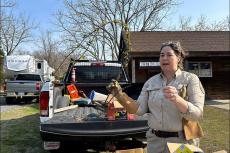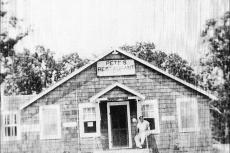Jack Youngerman, an important American artist for more than six decades, died on Feb. 19 at Stony Brook University Hospital of complications from a fall. He was 93.
Mr. Youngerman was one of the very few American artists — among them Jasper Johns, Robert Rauschenberg, Frank Stella, and Ellsworth Kelly — who cast a long shadow across the art world from the 1950s well into the current century. All five were selected by Dorothy Miller, a curator at the Museum of Modern Art, for its landmark 1959 exhibition “16 Americans.”
On learning of Mr. Youngerman’s death, Mr. Stella, who was a friend, said, “I miss Jack and I miss the enthusiasm and touch that made his paintings so striking. It was as though beauty was imprinted into the canvas of our time.”
In a 2014 interview in The Star, Mr. Youngerman recalled the art world of the 1950s. “You have to realize,” he said, “that in New York at that time Abstract Expressionism, and especially the work of Pollock and de Kooning, was considered by most people to be what painting was and would be far into the future.” He singled out Kelly and Rauschenberg in particular, who “in the midst of all that painterliness, pointed in new directions.”
A year before “16 Americans,” Mr. Youngerman had the first of six solo exhibitions at the influential Betty Parsons Gallery. More than 50 one-man shows at museums and galleries around the world followed, including a 1986 retrospective at the Guggenheim Museum in New York.
The road that led to his celebrated career began in the Midwest at a time when “being an artist wasn’t among the human possibilities for me. Artists were people who lived in Europe 300 years ago.”
Mr. Youngerman was born on March 25, 1926, in a suburb of St. Louis to Guy Youngerman and the former Margaret Everhart. The family moved to Kentucky three years later.
Mr. Youngerman earned a degree in journalism from the University of Missouri and, toward the end of World War II, entered a naval officers training program and was commissioned in December 1946. While on leave he was able to visit Washington, D.C., “so I could visit the National Gallery and see things everybody made such a big deal about.”
In the fall of 1947 he moved to Paris to enroll at the Ecole des Beaux-Arts on a G.I. Scholarship. On the way, he stopped in Manhattan and visited the Museum of Modern Art. “That was the first time I had seen any modern and contemporary art at all. I actually tried to enroll at the Art Students League first, but they had no room because there were so many ex-G.I.s back in school on the G.I. Bill.”
“He really hit the ground running in Paris,” said Janet Goleas, his archivist and studio manager. He met Kelly in 1948 and visited the studios of Constantin Brancusi and Jean Arp, whose use of organic form influenced him. In 1950 he married the French actress Delphine Seyrig, whose performance in Alain Resnais’s “Last Year at Marienbad” later brought her international recognition.
Their son, Duncan Pierre, was born in 1956. “Art saved my father,” he said in an email. “Through his daily discipline of 72 years, he transformed his inner tension inherited from a broken childhood into life-affirming visual grace for the rest of us to behold. His life was like the straight trajectory of an arrow powered by this single need to create.”
During his years in France, Mr. Youngerman visited the newly opened caves at Lascaux and traveled in the Middle East while visiting his father-in-law, Henri Seyrig, an archaeologist living in Beirut. In Paris he saw recent works by Matisse and became interested in the resurgence of geometric abstraction.
While Mr. Youngerman had been working figuratively when he first arrived in Paris, by 1949 he had abandoned figuration and within two years he was painting hard-edged abstractions that have characterized much of his painting and sculpture ever since. When Betty Parsons visited his Paris studio in the summer of 1956, she encouraged him to return to New York.
He took her advice that December, renting a space with his wife and son at Coenties Slip in Lower Manhattan. His friends and neighbors included Robert Indiana, Agnes Martin, Mr. Johns, Kelly, and Rauschenberg. “It’s amazing that within a few weeks of my return I met all the people who were on art’s cutting edge,” he told The Star. Through Rauschenberg he also met John Cage and Merce Cunningham.
After filming “Last Year in Marienbad” in 1961, Seyrig decided to remain in France with Duncan, and the couple separated. While Duncan lived in France during the school year, he would spend summers at Mr. Youngerman’s loft in New York. “It was difficult for him, so I started coming out to the Hamptons, renting for several summers.” Because he wanted a real workplace, he bought a house and studio on Scuttlehole Road in Bridgehampton in 1968.
Mr. Youngerman’s development was unique among his peers, with elemental forms and fluid contours that marked his paintings through the 1950s with imagery often emerging from a central core. As his career evolved, his interest in organic forms broadened to include relief paintings, shaped canvases, sculpture, works on paper, prints, and commissions.
“Jack was an artist of infinite grace and intelligence — in his art and in his life,” said Alicia Longwell, the chief curator at the Parrish Art Museum in Water Mill. “His quest for a universally understood abstraction yielded a limitless invention of forms, and he consistently sought to widen the possibilities for painting. A vital member of the East End artists community, his studio was always open to young artists, who must have taken away something of that exhilarating experience that he once felt in the heady days of 1950s Paris.”
His later work included intricately cut and layered wood reliefs and dazzlingly colored, symmetrical paintings on Baltic plywood. In 2013, well into his 80s, he installed seven fiberglass sculptures from the 1970s and 1980s at the LongHouse Reserve in East Hampton, showed large-scale paintings at Washburn Gallery in New York City, and exhibited six decades of small paintings and drawings at the Drawing Room in East Hampton.
Emily Goldstein, who is co-partner of the Drawing Room with Victoria Munroe, recalled Mr. Youngerman’s generosity. “Our 25-year friendship began when he entrusted me with curating a small exhibition of his works on paper. At the time I was overwhelmed by the privilege of his invitation to spend as long as I wished, quietly combing through decades of small gouaches and collages. He seemed somewhat surprised at the keen interest I took in the minute variations he explored in each abstract composition, and I felt I had been given the keys to the castle.”
Mr. Youngerman’s marriage to Ms. Seyrig ended in divorce. He is survived by his wife, Hilary Helfant, his son, Duncan Pierre, who lives in Meschers, France, and, from his marriage to Ms. Helfant, another son, Milo, who attends Kenyon College in Ohio. Four grandchildren also survive him.




